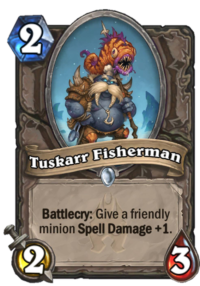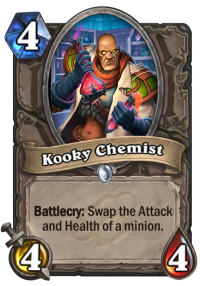Arena tier lists have been out there for quite some time now and at times it certainly can be a great tool while drafting a deck but it can also be a foe, leaving you short-sighted, unable to see the bigger picture. There is much more to drafting an arena deck than simply comparing the card rankings on any given list and by the end of this guide you will have a better grasp of what’s going on beyond the tier list.
We often find ourselves discussing or reading about the meta game and while that usually refers to standard competitive or ladder play it’s important to point out that arena has a meta of its own and it is crucial that we dissect it in order to better understand it.
The Arena Meta
First and foremost we need to comprehend the offering rates, meaning how often will a card show as a possible pick for our deck. Blizzard is often making balance changes to this in order to improve the arena experience and balance the classes. This happens in many ways, either by decreasing the odds of being offered Flamestrike or completely removing Vicious Fledgling from arena play. While these minor balance changes happen almost every patch the most important statistic to consider and the one that heavily dictates the arena meta is the 100% offering bonus for the latest expansion, in this case: Knights of the Frozen Throne. What that means is that you will be offered twice as many cards from KFT than any other set, including Classic.
Most expansions have a few key meta-defining cards for constructed play. We had Patches the Pirate in Mean Streets of Gadgetzan and in KFT we have the powerful Prince Keleseth. These cards shape ladder play as a whole and although for standard play it’s often legendary cards that have the most impact on the meta, in arena it’s all about the commons due to the aforementioned offering rates. Before we can dive into some of the key common neutrals from the latest expansion let us digress a bit about mana curve and mana efficiency.
Mana Curve & Efficiency
More often than not, the person who wins an arena match is someone that managed to play a 2-drop on turn 2, a 3-drop on turn 3, a 4-drop on turn 4 and so on. Having a good and balanced mana curve is more valuable and translates into more wins than perhaps having that one good 8-cost legendary that won’t see play or may never reach its full potential. Playing a 4-drop on 4 is way more valuable than playing it on 5. Let us consider the following example as a way to demonstrate this: It’s your turn 5, you have 5 mana available but you don’t have any 5-drops, only higher cost creatures, reaction spells and a 4-drop. So you play your Kooky Chemist and pass. Even though technically it only cost you 4 mana, since you did nothing else this turn and just passed to your opponent, this effectively cost you 5 mana instead of 4. Now it’s your opponent’s turn 5 and he manages to use all their mana and plays a 5-drop such as Nesting Roc. Now the board looks like this:
It’s clear that your opponent won that exchange and created a mismatch simply by playing a card on curve. Both these cards are ranked very close in most tier lists but what really made the difference in this scenario was playing it on curve.
One of the key aspects to building a successful arena deck is to make sure that you have something to play every turn in a way to use all of your mana efficiently. A tier list might rank Sated Threshadon above Bloodsail Raider and say it has more value, but it can never measure your mana curve at that given point of your draft when all you might need is a 2-drop. An unanswered 2-drop can make all the difference between winning and losing a match.
Arena matches are won on the board. That’s not to say that all that matters are minions since there are other ways to impact the board such as weapons and spells. However, this is the reason why Shadow Bolt is a much better arena card than Sinister Strike, it’s all about hitting the board as early as possible and maintaining it in order to eventually snowball your opponent while at the same time doing whatever you can to prevent your opponent’s board from developing out of control and snowball-ing you!
Optimize Your Game-Plan
Drafting an arena deck should be more than just comparing rankings or tier levels between 3 cards. Besides offering rates and mana curve, game-planning should also be a consideration. For instance if you are fortunate enough to draft enough early game cards to combine with an aggressive class such as the Hunter you may find yourself in a situation where you will have to pass on a Corrupted Healbot, a card that is often very good because of the board presence it generates at only 5 mana but in this particular case would directly contradict your game-plan. The same principle could apply to a Mage draft with excessive removal spells, which is often great, but too much could lead to a very reactive deck with no clear win condition.
Neutral Cards in Knights of the Frozen Throne
Now that we have established the importance of a mana curve and mana efficiency and are aware of the increased offering rates for the latest expansion lets apply this to the common neutral cards of KFT. These are the cards we will be seeing the most in arena, and therefore will dictate our experience and should be taken into consideration when drafting a deck.

The 2-mana spot is often the starting point of any planned curve while drafting an arena deck so let’s take a look at the neutral 2 drops from KFT which won’t take long since there are only three of them: Tainted Zealot that is essentially a 1-drop (Argent Squire) that costs 2 instead. Fallen Sun Cleric that even though has a decent battlecry at 1 hp it’s very vulnerable to many hero powers and isn’t a good first card to play. Which leaves us with one 2-drop: Tuskarr Fisherman. Your favorite tier list may not regard him very highly on their rankings, you will find yourself drafting this card more than you’d think because this is the lowest offering rate of 2-drops ever in arena and the Fisherman may be all you got standing between you and a hero power pass turn 2.
If we don’t have the luxury of drafting a deck with as many 2-drops as we would’ve liked we better make sure our 3-drops count and KFT sure gave us tools for that. In the current meta it is really important to have good 3-drops because often it will be your first card played and therefore will trade into your opponent’s 2-drop and hopefully survive to trade again into their 3 or 4 drop in order to buy back the tempo lost by not playing anything the previous turn. There are a bunch of good class specific 3-drops in KFT like Coldwraith and Bearshark but the king of the hill has to be the neutral Hyldnir Frostrider standing at an impressive 4/4 and often demands a 2 for 1 card exchange. So, if you’re thinking about passing on this card during the draft, think again. Carefully.
Conclusion
The most exciting and entertaining aspect of arena is that no match, opponent, or run will ever be the same. It’s always different and the possibilities are endless and it’s definitely not something easy to master, so make use of the great tool that is the tier list but don’t exclusively rely on it for every decision. Even people who have created these lists, generally very good arena players, will tell you so. Take into consideration what I pointed out in this piece and combine it with your own experiences and try to make the best out of what is offered to you.
Be safe out there and beware of the Bonemare.



